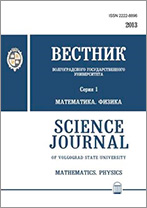|
This article is cited in 1 scientific paper (total in 1 paper)
Applied mathematics
On the theory of hydrate formation in the tubular reactor at the injection of water droplets and gas
V. Sh. Shagapovab, A. S. Chiglintsevaca, G. A. Kunsbaevad
a Research Institute of Mechanics and Machinery of Kazan Scientific Center of the Russian Academy of Sciences
b Institute of Mechanics, Ufa Centre of the Russian Academy of Sciences
c Birsk branch of the Bashkir State University
d Sibai Institute (Branch of Bashkir State University)
Abstract:
The paper presents a flow diagram of a tubular reactor used to form a hydrate by injecting gas and water droplets at temperatures and pressures that correspond to the condition of hydrate formation. The authors described theoretically the model and numerical results that are presented for possible hydrate in a horizontal channel. According to the mathematical model of the intensity of the hydrate formation the authors described gas diffusion theory, which suggests that the growth rate of the hydrate layer on the surface of the water bubble of gas is limited by diffusion to the boundary of the contact hydrate–water.
As a result of numerical experiments and theoretical calculations presented in the work it was found that for different values of volume fraction of the droplets of water injected to the reactor, there are several possible modes of hydrate formation process:
1) The temperature in the reactor reaches an equilibrium value for a given pressure, wherein the water phase does not have time to go to completely hydrated state;
2) The water phase is completely converted into the hydrate, but the temperature in the reactor reaches an equilibrium value;
3) There is a full hydrate, and the temperature in the reactor is equal to the equilibrium temperature of hydrate formation.
Thus, providing appropriate thermobaric conditions and selecting the specific parameters for the hydrate-forming constituents entering the reactor, it is possible to achieve the best of its size and the most complete transition of the aqueous phase in the hydrate state.
Keywords:
hydrated particles, injection, water droplets, gas, hydrate formation, gas diffusion, tubular reactor, hydrate layer.
Citation:
V. Sh. Shagapov, A. S. Chiglintseva, G. A. Kunsbaeva, “On the theory of hydrate formation in the tubular reactor at the injection of water droplets and gas”, Vestnik Volgogradskogo gosudarstvennogo universiteta. Seriya 1. Mathematica. Physica, 2016, no. 1(32), 38–47
Linking options:
https://www.mathnet.ru/eng/vvgum93 https://www.mathnet.ru/eng/vvgum/y2016/i1/p38
|

| Statistics & downloads: |
| Abstract page: | 118 | | Full-text PDF : | 39 | | References: | 40 |
|




 Contact us:
Contact us: Terms of Use
Terms of Use
 Registration to the website
Registration to the website Logotypes
Logotypes








 Citation in format
Citation in format 
